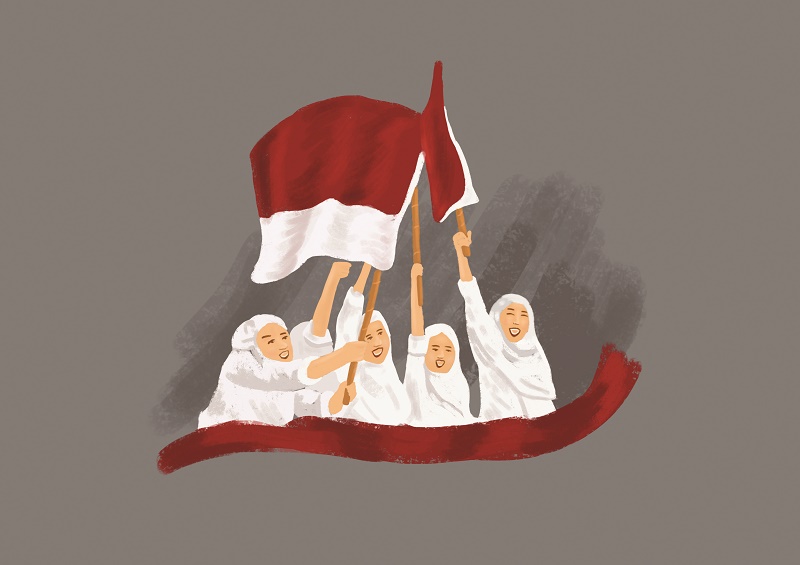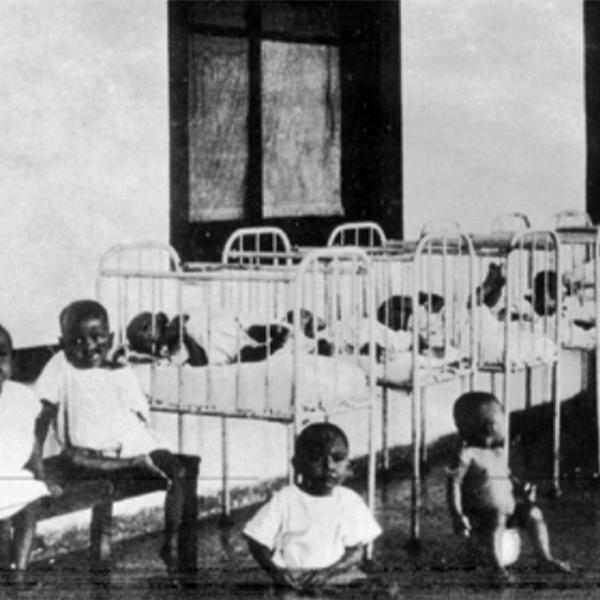
https://www.imm-renaissance.or.id
oleh Andita Eka Wahyuni
National identity has always been a prominent element for the nation to preserve unity. Increasingly, in the globalized world, national identity remains the fundamental aspect whose strategy needs to be evolved with the current era since it is considered as an essence of social constructions (Kong & Yeoh, 1997). The case of Indonesian exemplifies this well. As a nationalist country, Indonesia has gone through histories in developing its nationalism project. Cited from Latif (2011) in Negara Paripurna, the development of nationalism awareness in Indonesia is divided into archaic nationalism, proto-nationalism, and modern nationalism. This development has shown a significant improvement in the aim to perform a better strategy of building nationalism awareness. Concerning the fact as a diverse nation, Indonesia mainly focuses on creating unity to minimize and avoid conflicts among the people. Particularly, the attention has been paid mostly on the six indicators of nationalism proposed by Iskandar as cited in Akbar (2017), which include the sense of pride, sense of Bhinneka Tunggal Ika, sense of fighting spirit, sense of unity spirit, diplomacy, and sense of affection to the homeland. Thus, several agendas aside from educating people through formal education and events have been proliferated to continuously carry out the nationalism agenda and maintain the unity of the nation (Ruslan, 2014) especially in the globalization era (Akbar, 2017). For instance, reproducing a story that glorifies the history of gaining independence such as in the movie of Merah Putih (2009). Aligning with a similar issue on a movie as a tool to shape the sense of nationalism to the audiences (Sari, 2013), this essay will take into account the family movies that may also perform as a promising genre to build nationalism. It has also been considered based on the idea of ‘home’ that is clearly and explicitly depicted in family movies.
The whole idea of home depicted through family movies is the important element of the story through which I believe can be considered as another form of nation’s metaphor. The idea of home in connection as the metaphor of the nation has been used interchangeably. Šaric & Stanojevic (2019) mentioned that in some cases, political actors have widely used the metaphor of ‘home’ in referring to the state of a country. It is a constitutive metaphor in proffering unity. ‘Home’ as a concept has several scales of meanings among people in the world, including self-identity, relationships with family, a physical resting place, cultures, the nation, and even the planet (Davies, 2014). Consequently, this essay proposes the idea of home within two concepts; home as space that compresses many normative values associated with family and home that is associated with the nation and unified national identity. This concept can appear ubiquitously, sometimes so ubiquitous that people do not even notice when it is being invoked (Davies, 2014). This idea, as I concern, seems to be mirrored in popular culture and has made the idea of home can be potentially effective to be reinforced and wrapped in movies under the genre of family drama.
The following essay deals with the idea of home as the metaphor of a nation that is invoked through the family movies. As far as these three variables; family movies, ‘home’, and nation; are concerned and connected, I believe that the reinforcement of belonging to the nation through family movies can work, effectively, beyond expectation. It has also been considered based on the idea of ‘home’ that is clearly and explicitly depicted in family movies.
Therefore, I am going to find the logical answers to the proposed question: To what extent does the Indonesian family movies can invoke the sense of belonging to the nation? The essay will attempt to illustrate the significant elements portrayed in Indonesian family movies that might be a potential element to convey messages about national belongings. I also claim that this illustration of the connection of family movies and national identity will introduce a new analytical perspective to the study of nationalism. At the same time, the objective of the essay is to maintain and contribute to the chain of knowledge about home as the metaphor of a nation.
The exploration of building national identity has always been an open-ended discussion among scholars. There have been numerous issues proposed to discuss various strategies for building national identity in a globalizing world. The proliferation of claims within cultural identity has also been identified. In an interesting study, Kimura (2016) exposed how food has significant implications to represent the national identity among the people and as an engaging representation under the context of environmental sustainability, international trade, health, and cultural identities. It unconsciously describes an idea about food, as the element of everyday life, which can be part of building a national identity. In the same line with Kimura, Edensor (2002) has explored the relationship of national identity to popular culture and everyday life. As far as Edensor has concerned, building national identity has always been a part of mundane activities and popular cultures through which the nation, in that way, is more experienced and understood. Accordingly, Davies (2014) illustrated how the children book of Travelling Light has described an idea of a nation as the safest place from dangerous and vulnerable life outside. In that way, Davis also expressed that the book also tries to invoke the idea of the motherland to the readers.
Similarly, Imanjaya & Kusumawardhana (2016) has also depicted the role of popular culture in building a national identity. Analysing the movie of Laskar Pelangi (2008) and Eat, Pray, Love (2010), Imanjaya examined how these movies could be a good representation to depict Indonesia through the beauty of tourism induced in the movies. The study reveals that stories and pictures elaborated with the characters’ emotions shown through the movie are powerful elements to implicitly persuade the audiences in such an engaging way. A different study on building national identity has also proposed by Šaric (2019) by adopting the notion of discourse under the crucial aspect of building a national identity. It is argued that “The nation” is constructed and deconstructed in discourse. Consequently, Šaric also examined the use of metaphors in constructing national identity.
For although there have been many studies on building national identity under the notion of nationalism, few have been subject to the analysis of how it is represented and experienced through popular culture and in everyday life. Thus, as the focus of this essay will be on family movies, several Indonesian movies are selected among the best practices of the trend (Nural, 2018), which are 9 Summers 10 Autumns (2013), Sabtu Bersama Bapak (2016), Cek Toko Sebelah (2017), Bunda: Cinta Dua Kodi (2018), Keluarga Cemara (2019). All of these movies support many similar meanings, notably, that family will always be an essential part of someone’s life that provides comfort, support, and a sense of security. It also delivers messages that, in the end, the family will always be a place for anyone to go home no matter what happens. Thus, it illustrates that the idea of home does not only refer to the physical or spatial location but also the psychological aspect to the perception of feeling.
Concerning the above-mentioned issue, the discussion on this essay focuses on two aspects depicted in family movies, which are material and psychological dimensions, and in correlation with building national identity under the notion of home as the metaphor of nation. The material dimension will give a discussion on how the idea of home in family movies constitutes with the spatial aspect in everyday living through which it evokes the structural and conceptual place of the home in the surrounding environment. Moreover, the psychological dimension will focus on the notion of how the emotional aspect depicted in family movies could resonate with the feeling of compassion, harmony, unity, and loyalty towards the family.
Persisting the national identity through the physical terms is a complex agenda that brings together a number of strategies especially in the case of Indonesia. The relationship between space and national identity is commonly constituted by borders, symbolic areas and sites, and dwelling places (Edensor, 2002). Thus, it brings the idea of home as part of the matter in connecting the physical dimension with national identity. There has been a range of different national forms of spatialization that interweave with each other and the idea of home has become the commonly known form to build a strong cognitive of national identity (Czepczyński, 2020). In family movies, the physical dimension of a home is frequently invoked through the portrayal of a comfortable house and beauty nature although it is shown in homely space. Moreover, this homely space is the fore aspect in the movie that is pervaded with familiarity in the distribution of numerous other elements. Within this concept, surrounded by familiar things, someone will build a certain engagement with the physical space in which they live – and such forms are the memories that someone is cherished on. Whilst these spaces might be considered as collective forms through which places are known, I would also consider this collectiveness as part of a powerful and influential sense of national spatialization.
The idea of spatialization has been undertaken as part of constructing national identity through the means of familiarity with certain landscapes. Thus, through the portrayal of family movies in which the discourse of home and family are put together could be an engaging yet powerful notion to invoke national identity. Likewise, the reinforcement signified by the regular pattern of familiar things constitutes a sense of being in place in most locations within the nation (Edensor, 2002). For instance, through the depiction of landscapes in family movies in which the characters build the proximity and feel the conformity, the audiences are also invoked by the similar feelings; that the idea of familiarity might bring comfortability, somehow, creates the sense of belonging to the place where someone lives. Edensor mentions that the familiarity which surrounds someone conveys familiar kinds of comfort (2002). Furthermore, it invokes the idea that when the familiarity is missing or threatened, it will lead to discomfort and disorientation. Therefore, the idea of home is dynamic and connected with the networked space; it links the pattern of familiarity together, from the small-scale domestic to the large-scale nation, and leads to the definition that passes into the world beyond the house only.
In this psychological dimension, the notion of comforting through certain affections plays a great role. The main messages delivered in family movies are the reinforcement of what it truly means about family. As the essence of re-enactment, a movie can be a potential media to invoke certain emotions (Hayward, 2015) including the notion of harmonious family. Within the concept of nationalism, the idea of a harmonious family is everything related to unity. In the case of Indonesia, the term unity in diversity has been mainly used among various discourses; none other to create a sense of solidarity and equality among its diverse people. As in this case, the idea of home portrayed through family movies could be a useful concept to promote a sense of belonging towards family and of connection among the members. Particularly, the implied messages, in relation to national identity, are that the family also tries to invoke the notion of family as a small version of unity withing the bigger version of a nation. Thus, at a certain point, when the sense of engagement is bounded, the idea of a home might be seen as a community with a commitment to maintaining solidarity with each other. This goes in line with the notion of imagined communities by Anderson to which the people start feeling the same experience and building a horizontal comradeship (1983).
At this point, within the concept of home in psychological dimension, the audiences are most likely invoked with the messages; that they belong to a nation just like how a person belongs to a certain family, that the sense of unity among individuals or groups is as important as the unity among family members, and that a nation is a concept of a bigger family to which all the people should always be together to gain a glory and well-being life. Throughout the common story in Indonesian family movies, the plot mostly will end by implying the notion that family will be the best place to go home no matter what happens. Hence, the movies portray the importance of finding home when anything goes unwell because the family will be able to normalize the irregular.
In conclusion, Indonesian family movies could possibly invoke the idea of national identity within the concept that home is the metaphor of a nation. Particularly, the family movies illustrate the ‘home’ as the process of attachment both to the place (physical dimension) and people (psychological dimension) within the concept of a nation.
Penulis adalah Kader Rayon PMII Al Maturidi
References
Anderson, B. R. (1983). Imagined Communities. London, New York: Verso.
Anderson, B. R. (1999). Indonesian Nationalism Today and In The Future. Indonesia: Digitised by Monash University Library.
Boediman, A. (2018, March 30). Ideosource Film Fund: Investing in Indonesian Filmmakers. Retrieved from Medium: https://medium.com/@andiboediman/ideosource-film-fund-investing-in-indonesian-filmmaker-37704274fd23
Czepczyński, M. (2020). Identity and nation building in everyday post-socialist life. Journal Eurasian Geography and Economics. doi:10.1080/15387216.2020.1740607
Davies, M. (2014). Home and state: reflections on metaphor and practice. Griffith Law Review, 23(2), 153-175. doi: 10.1080/10383441.2014.962447
Edensor, T. (2002). National Identity, Popular Culture, and Everyday Life. New York: Berg.
Hayward, S. (2015). Cinema Studies: The Key Concepts (Second Edition). London & New York: Routledge.
Imanjaya, E., & Kusumawardhana, I. (2016). Film Tourism Indonesian Style: The Cases of Laskar Pelangi and Eat Pray Love. Journal of Communication Studies, 3(2), 9-27.
Kharis Maulana Akbar, L. H. (2017). Semangat Nasionalisme Dalam Film (Analisis Isi Kuantitatif dalam Film Merah Putih). ProTVF, 1(2), 125-138. Retrieved from journal.unpad.ac.id
Kimura, M. (2016). Food, national identity and nationalism: from everyday. Ethnic and Racial Studies. doi:10.1080/01419870.2016.1161813
Kong, L., & Yeoh, B. S. (1997). The Construction of National Identity through the Production of Ritual and Spectacle: An Analysis of National Day Parades in Singapore. Political Geography, 16(3), 213-239. Retrieved from https://ink.library.smu.edu.sg/soss_research/1746
Latif, Y. (2011). Negara Paripurna: Historitas, Rasionalitas, dan Aktualitas Pancasila. Jakarta: Gramedia Pustaka Utama.
Nural. (2018, June 16). 5 Film Indonesia tentang Pentingnya Keluarga. Retrieved from Kincir: https://www.kincir.com/movie/cinema/5-film-indonesia-pentingnya-keluarga
Robinson, T. (2019, October 4). Love it or hate it, the Joker movie presents a tempting fantasy. Retrieved from The Verge: https://www.theverge.com/2019/10/4/20899422/joker-movie-review-todd-phillips-joaquin-phoenix-incel-violence-dc-comics-batman
Rumani, S. (2019, January 5). Kompasiana. Retrieved from Keluarga sebagai Benteng Badai Kehidupan dalam Film “Keluarga Cemara”: https://kompasiana.com/srirumani/5c309f7e677ffb6cd20348f7/keluarga-sebagai-benteng-badai-kehidupan-dalam-film-keluarga-cemara
Ruslan, I. (2014). ‘Membangun’ Nasionalisme sebagai Solusi untuk Mengatasi Konflik SARA di Indonesia. Jurnal TAPIs, 10(1), 1-18.
Šaric, L., & Stanojevic, M.-M. (2019). Metaphor, Nation, and Discourse. John Benjamins Publishing Company.
Sari, Rina Fakum Indria. (2013). Representasi nasionalisme dan patriotisme
Dalam film “Tanah surga.. Katanya” (Thesis, Universitas Muhammadiyah Surakarta, Central Java, Indonesia). Retrieved from http://eprints.ums.ac.id/27341/
sumber foto : https://www.imm-renaissance.or.id







